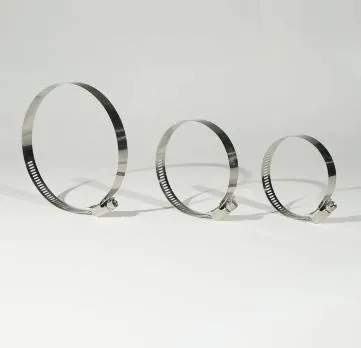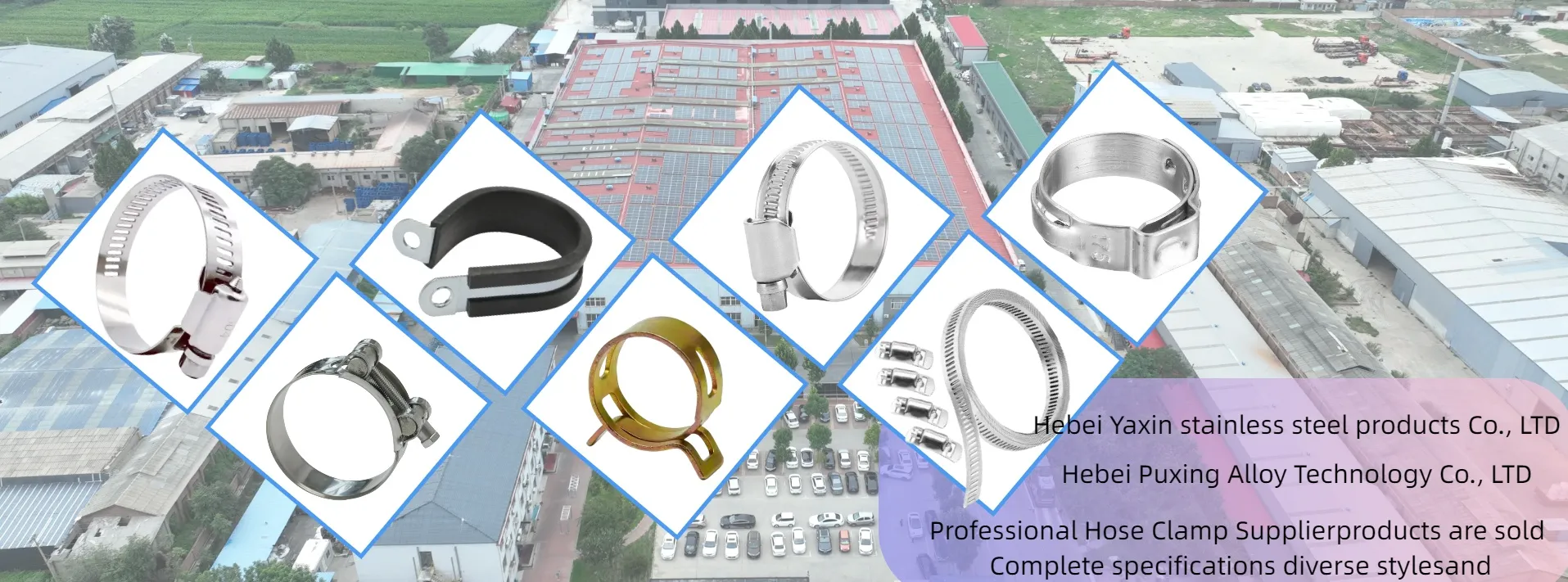- Phone:+86-17331948172 +86-0319-8862898
- E-mail: inquiry@puxingclamp.com
កក្កដា . 28, 2025 10:49 ត្រឡប់ទៅបញ្ជី
Installation Challenges and Tool Requirements Across 104 Hose Clamp
Hose clamps are indispensable for securing connections in fluid and gas systems, but their installation complexity varies dramatically with size. For wholesalers supplying 1/8 hose clamps, 10 hose clamps, and 104 hose clamps, understanding the unique challenges and tool requirements for each size is critical to meeting bulk buyer demands. This article explores installation nuances, industry-specific tooling, and wholesale strategies to optimize efficiency and reliability across applications.

1/8 Hose Clamps: Precision Tools for Delicate Applications
1/8 hose clamps are designed for small-diameter tubing in medical devices, electronics, and precision instrumentation. Their installation demands meticulous attention to avoid damaging fragile components.
Due to their size, these clamps often require specialized tools for precise and secure placement. Manufacturers must ensure that the clamping force is evenly distributed to prevent leaks and maintain the integrity of the system. Additionally, the materials used in 1/8 hose clamps must be compatible with the fluids or gases they are intended to contain, ensuring both safety and performance.
Torque-Limited Screwdrivers: Prevent overtightening, which can crush tubing or strip screws. A torque range of in-lbs is typical.
Micro-Crimping Tools: For 1/8 hose clamps with permanent crimp designs, specialized handheld crimpers ensure uniform pressure without distortion.
Accessibility: Tight spaces in devices like ventilators or fuel injectors require angled or magnetic drivers.
Material Sensitivity: Thin-walled silicone or PTFE tubing can tear if clamps are misaligned.
For wholesalers, bundling 1/8 hose clamps with compatible precision tools adds value for clients in regulated sectors like aerospace or healthcare.
10 Hose Clamps: Balancing Strength and Efficiency in Industrial Settings
10 hose clamps are workhorses in automotive, HVAC, and oil/gas industries, securing mid-sized hoses under moderate pressure and vibration.
Pneumatic Screwdrivers: Speed up installation in assembly lines while maintaining torque consistency.
Band Tightening Pliers: Essential for worm-gear 10 hose clamps, ensuring even tension without twisting.
Alignment Issues: Misplaced clamps on large hoses can cause leaks. Laser-guided tools improve accuracy.
Vibration Resistance: In engines or pumps, 10 hose clamps require periodic re-tightening unless self-locking designs are used.
Wholesalers should stock corrosion-resistant 10 hose clamps for chemical plants.
104 Hose Clamps: Heavy-Duty Solutions for Mega-Infrastructure Projects
104 hose clamps are used in mining, maritime, and civil engineering to secure massive pipelines, slurry systems, or dam infrastructure.
Hydraulic Torque Wrenches: Generate the high torque needed to tighten 104 hose clamps without worker strain.
Custom Installation Rigs: Cranes or scaffolding systems position clamps on oversized hoses, which can weigh thousands of pounds.
Safety Risks: Workers handling 104 hose clamps face pinch hazards; reinforced gloves and robotic assists are recommended.
Environmental Exposure: Offshore or mining applications demand clamps with duplex stainless steel or epoxy coatings to resist saltwater or abrasives.
Bulk buyers of 104 hose clamps prioritize modular designs for field adjustments and certifications.
Wholesale Strategies for Diverse 104 Hose Clamp Installations
Tool Bundling: Pair 1/8 hose clamps with precision drivers, 10 clamps with pneumatic tools, and 104 clamps with hydraulic kits to streamline bulk orders.
Certification Compliance: Ensure clamps meet medical, oil/gas, or ISO 9001 standards for global buyers.
Custom Packaging: Use crush-proof boxes for 1/8 hose clamps and palletized crates for 104 hose clamps to minimize transit damage.
Training Resources: Provide installation guides or video tutorials to help clients optimize clamp performance across sizes.
By aligning inventory with industry needs, wholesalers reduce lead times and build trust with high-volume buyers.
FAQ: Addressing 104 Hose Clamp Installation Queries
What tools are essential for installing 1/8 hose clamps in medical devices?
Torque-limiting screwdrivers and anti-static micro-crimpers are critical to avoid damaging sensitive tubing in devices like dialysis machines or respirators.
Can 10 hose clamps withstand high-pressure hydraulic systems?
Yes, if made from high-tensile stainless steel and installed with pneumatic tools calibrated to 35 ft-lbs. Ensure compliance.
Are 104 hose clamps reusable after removal?
Rarely. Due to deformation during installation and exposure to extreme stress, 104 hose clamps are typically single-use in mega-projects like dam systems.
How do I prevent overtightening 1/8 hose clamps?
Use torque-controlled tools and follow manufacturer specs. Over-tightening risks tubing collapse, especially in silicone or polymer lines.
Which industries most commonly use 104 hose clamps?
Mining (slurry transport), maritime (ship engine cooling), and civil engineering (stormwater management) rely on 104 hose clamps for large-scale infrastructure.
From delicate 1/8 hose clamps to colossal 104 hose clamps, installation success hinges on matching the right tools to each size’s unique demands. For wholesalers, offering certified products, bundled tooling solutions, and industry-specific expertise ensures clients achieve reliable, long-lasting connections. By mastering these challenges, distributors position themselves as vital partners in sectors where precision, durability, and safety are non-negotiable.
Moreover, adapting to the diverse needs of various industries is crucial. Whether it's the automotive sector requiring robust clamps for high-pressure hoses, or the agricultural industry needing versatile clamps for irrigation systems, understanding these specific applications enables distributors to provide tailored solutions. Continuous innovation in clamp design and material science further enhances the performance and reliability of these connections, solidifying their role as indispensable suppliers in safety-critical environments.
-
Material Selection for Corrosion Resistance and Durability in 1.5 Hose Clamps
ព័ត៌មានJul.28,2025
-
Maintenance and Longevity: Prolonging Worm Hose Clamp Lifespan
ព័ត៌មានJul.28,2025
-
Installation Challenges and Tool Requirements Across 104 Hose Clamp
ព័ត៌មានJul.28,2025
-
Innovations in Spring Hose Clamp Technology: Smart and Sustainable Solutions
ព័ត៌មានJul.28,2025
-
Formability and Fabrication Techniques for 201 Stainless Steel Strips
ព័ត៌មានJul.28,2025
-
Corrosion Resistance in Environments: A Guide for Washer Hose Clamps
ព័ត៌មានJul.28,2025




